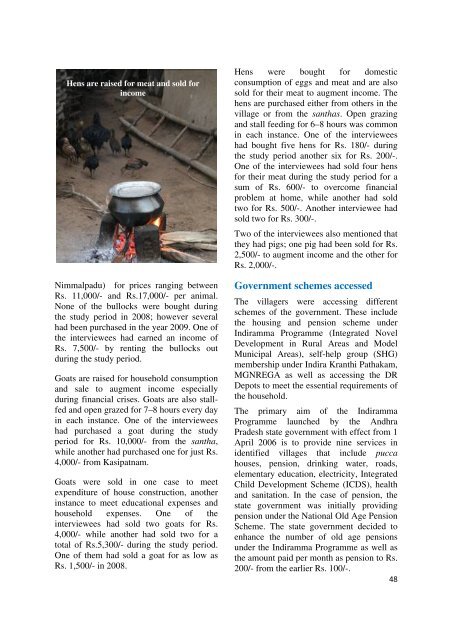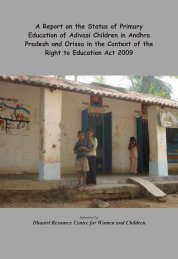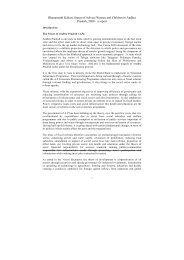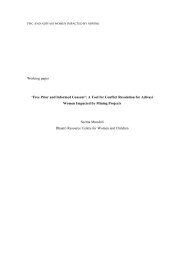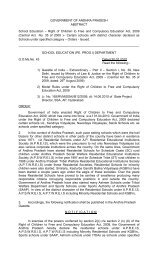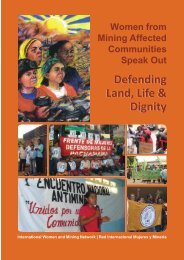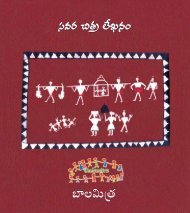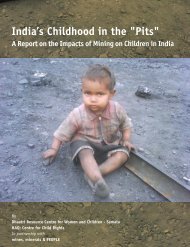Impacts of Government Policies on Sustenance of Tribal ... - Samata
Impacts of Government Policies on Sustenance of Tribal ... - Samata
Impacts of Government Policies on Sustenance of Tribal ... - Samata
You also want an ePaper? Increase the reach of your titles
YUMPU automatically turns print PDFs into web optimized ePapers that Google loves.
Hens are raised for meat and sold forincomeNimmalpadu) for prices ranging betweenRs. 11,000/- and Rs.17,000/- per animal.N<strong>on</strong>e <str<strong>on</strong>g>of</str<strong>on</strong>g> the bullocks were bought duringthe study period in 2008; however severalhad been purchased in the year 2009. One <str<strong>on</strong>g>of</str<strong>on</strong>g>the interviewees had earned an income <str<strong>on</strong>g>of</str<strong>on</strong>g>Rs. 7,500/- by renting the bullocks outduring the study period.Goats are raised for household c<strong>on</strong>sumpti<strong>on</strong>and sale to augment income especiallyduring financial crises. Goats are also stallfedand open grazed for 7–8 hours every dayin each instance. One <str<strong>on</strong>g>of</str<strong>on</strong>g> the intervieweeshad purchased a goat during the studyperiod for Rs. 10,000/- from the santha,while another had purchased <strong>on</strong>e for just Rs.4,000/- from Kasipatnam.Goats were sold in <strong>on</strong>e case to meetexpenditure <str<strong>on</strong>g>of</str<strong>on</strong>g> house c<strong>on</strong>structi<strong>on</strong>, anotherinstance to meet educati<strong>on</strong>al expenses andhousehold expenses. One <str<strong>on</strong>g>of</str<strong>on</strong>g> theinterviewees had sold two goats for Rs.4,000/- while another had sold two for atotal <str<strong>on</strong>g>of</str<strong>on</strong>g> Rs.5,300/- during the study period.One <str<strong>on</strong>g>of</str<strong>on</strong>g> them had sold a goat for as low asRs. 1,500/- in 2008.Hens were bought for domesticc<strong>on</strong>sumpti<strong>on</strong> <str<strong>on</strong>g>of</str<strong>on</strong>g> eggs and meat and are alsosold for their meat to augment income. Thehens are purchased either from others in thevillage or from the santhas. Open grazingand stall feeding for 6–8 hours was comm<strong>on</strong>in each instance. One <str<strong>on</strong>g>of</str<strong>on</strong>g> the intervieweeshad bought five hens for Rs. 180/- duringthe study period another six for Rs. 200/-.One <str<strong>on</strong>g>of</str<strong>on</strong>g> the interviewees had sold four hensfor their meat during the study period for asum <str<strong>on</strong>g>of</str<strong>on</strong>g> Rs. 600/- to overcome financialproblem at home, while another had soldtwo for Rs. 500/-. Another interviewee hadsold two for Rs. 300/-.Two <str<strong>on</strong>g>of</str<strong>on</strong>g> the interviewees also menti<strong>on</strong>ed thatthey had pigs; <strong>on</strong>e pig had been sold for Rs.2,500/- to augment income and the other forRs. 2,000/-.<str<strong>on</strong>g>Government</str<strong>on</strong>g> schemes accessedThe villagers were accessing differentschemes <str<strong>on</strong>g>of</str<strong>on</strong>g> the government. These includethe housing and pensi<strong>on</strong> scheme underIndiramma Programme (Integrated NovelDevelopment in Rural Areas and ModelMunicipal Areas), self-help group (SHG)membership under Indira Kranthi Pathakam,MGNREGA as well as accessing the DRDepots to meet the essential requirements <str<strong>on</strong>g>of</str<strong>on</strong>g>the household.The primary aim <str<strong>on</strong>g>of</str<strong>on</strong>g> the IndirammaProgramme launched by the AndhraPradesh state government with effect from 1April 2006 is to provide nine services inidentified villages that include puccahouses, pensi<strong>on</strong>, drinking water, roads,elementary educati<strong>on</strong>, electricity, IntegratedChild Development Scheme (ICDS), healthand sanitati<strong>on</strong>. In the case <str<strong>on</strong>g>of</str<strong>on</strong>g> pensi<strong>on</strong>, thestate government was initially providingpensi<strong>on</strong> under the Nati<strong>on</strong>al Old Age Pensi<strong>on</strong>Scheme. The state government decided toenhance the number <str<strong>on</strong>g>of</str<strong>on</strong>g> old age pensi<strong>on</strong>sunder the Indiramma Programme as well asthe amount paid per m<strong>on</strong>th as pensi<strong>on</strong> to Rs.200/- from the earlier Rs. 100/-.48


